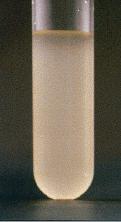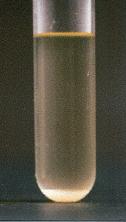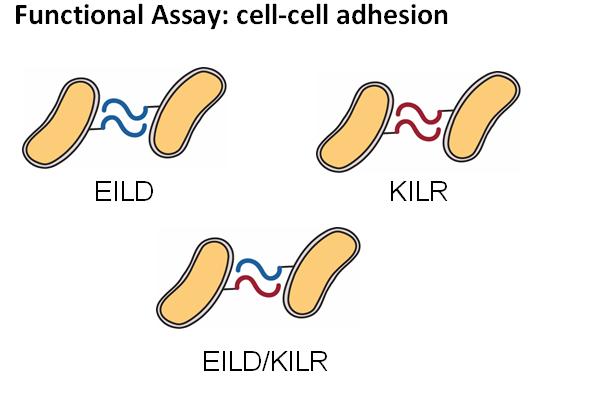Team:Berkeley Wetlab/Passenger: Leucine Zippers
From 2009.igem.org
Leucine Zippers
One potential use of cell surface display is to adhere cells together selectively such that there is structure. However, such a feat is impossible to do in one step. In order to work up to such a goal, the first step of such an endeavor is create a basic system of adhere 2 cells types together. We propse using dimeric leucine zippers to adhere cells to one another. Leucine zippers are short peptides which form alpha helices that compliment each other. Using a GNC4 leucine zipper heterodimers KILR and EILD, we hoped to adhere cells to one another.
Functional Assay: Cell-Cell Adhesion
This assay tests for the functionality of displayed leucine zippers via the leucine zipper's ability to dimerized and, as a result, pull the cells out of solution into a clump.
Constructs:
EILD, leucine zipper (14)
KILR, leucine zipper (14)
EILD + KILR (14) (EILD can heterodimerize with KILR)
1363 negative control (1) (Periplasm targeted strepavidin binding protein)
CPG L2 positive control(1) (Leucine zipper previously shown to cause cell-cell adhesion
All experiments are done in triplicate
cell growth and induction
1. Grow a cells of each typein a liquid culture overnight to saturation.
2. Make a 1:1000 dilution the following day of the saturated cultures and innoculate with arabinose (100 μg/mL final concentration) and incubate for 24-48 hours. For the the EILD + KILR sample add both EILD and KILR to grow both cell types in the same tube. Grow in a 24 well v-bottom block , 3 ml of media in each well.
assay cell clumping
After induction for 24-48 hours, there should be some cell-cell clumping. The supernatant of the wells with clumping should be clear.
1. Pipette up and down 10 times with a 1000 ul pipette for all samples to get cells that settled back into suspension. Either confirm clumping visually or take an OD 600.
2. For the OD 600, take 200 ul of supernatant from the top left corner of each well and put that into a 96 well plate.
3. Take an OD 600 of the samples in the 96 well plate. Wells with clumped cells should have significantly lower OD 600s as there should be no less cells inthe supernatant.
Example from the literature

Normal cultures grown to saturation are cloudy.

Clumping causes the cells to be pulled out of solution, leaving a clear supernatant.
Results
Data
Conclusion
After running the assay, activity was observed for all leucine zipper constructs both as homodimers and heterodimers independent of the display system chosen. This contrasts other results when compared to other passenger data such as the strepavidin binding peptide which seems to have context based effects. Unlike the strepavidin binding peptide, the leucine zipper functions well, even without the INP repeats.
References
Esteban Veiga, Víctor de Lorenzo, and Luis Angel Fernández. Autotransporters as Scaffolds for Novel Bacterial Adhesins: Surface Properties of Escherichia coli Cells Displaying Jun/Fos Dimerization Domains. Journal of Bacteriology. September 2003; 185(18): 5585–5590. Available online at: http://www.ncbi.nlm.nih.gov/pmc/articles/PMC193771/
Kristian Kjærgaard, Mark A. Schembri, Henrik Hasman, and Per Klemm. Antigen 43 from Escherichia coli Induces Inter- and Intraspecies Cell Aggregation and Changes in Colony Morphology of Pseudomonas fluorescens. Journal of Bacteriology. September 2000; 182(17): 4789–4796. Available online at: http://www.ncbi.nlm.nih.gov/pmc/articles/PMC111355/
 "
"









